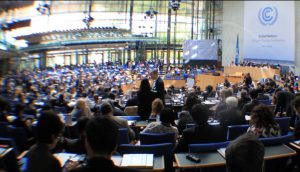Energy consumed to supply heat and electricity to China’s vast building sector—energy that is mainly derived from coal—could start to peak by the end of the decade, says a new report from the Ministry of Housing and Urban-Rural Development, in line with the broader government target to cap use of the fossil fuel.
Published in partnership with an academic panel, the report predicts that a cap on coal consumption of 4.3 million tonnes annually by 2020 would help China’s buildings sector peak in energy use at an annual 245 million tonnes of coal equivalent (tce) by the end of the decade.
Energy consumption in buildings comprises 30% of China’s primary energy consumption, according to research from Tsinghua University and Germany’s Ministry of Industry and Commerce.
Yang Fuqiang, senior advisor on Climate, Energy and Environment for the US-based National Resources Defense Council, said that unless major changes are made in how China’s buildings consume energy, the sector could account for over 35% of energy use by 2050, placing enormous strain on China’s energy supply, resources and environment.
“Energy-saving buildings are crucial for society’s efforts to save energy and cut emissions,” Yang says.
With current rates of economic growth and business-as-usual patterns of urbanisation, the report predicts that in 2030 China’s buildings will consume 1.11 billion tce, which would slow the country’s progress towards a planned peak in greenhouse gas emissions in the same year.
A twofold effect is needed to deliver a peak in energy consumption from the building sector and then drive down consumption of heat and power up to 2030 and beyond.
Firstly, the rate of energy efficiency in Chinese buildings needs to rise sharply from current levels.
According to the report, energy-saving projects could reduce energy use by a total of 130 million tce, or 300 billion kilowatt hours. But achieving that scenario will require major investment—an estimated 3.6 trillion yuan (US$580 billion) between 2016 and 2030 if all potential energy savings are to be made.
Efforts to develop green buildings in China have been thwarted by overlapping levels of government bureaucracy and the high costs of equipping, installing and monitoring energy efficient technologies such as insulation, smart metres and appliances, as well as small-scale renewable energy systems.
China has already earmarked greener growth in cities as a major pillar of its 13th five-year plan (2016-2020) but may require tougher enforcement and stronger incentives to help deliver the results expected of the buildings sector.
Responsibility
Dividing responsibility for building in green technology is also complicated by ownership and rental models in urban China, where demand for new and affordable new housing has often outstripped priorities for energy efficiency.
A second effort to reduce the amount of energy used in China’s buildings will involve switching electricity produced at source—requiring China to shift away from highly-energy intensive coal-fired power stations to those that use cleaner-burning gas or renewables.
China is steadily rolling out its gas pipeline network to more Chinese cities, enabling them to switch from highly-polluting and carbon-intensive coal-fired boilers to gas or even solar in district and water heating.
Urban drift
By 2030, China will have 60 billion square metres of urban residential buildings, and 1 billion of its people will live in cities, the World Bank estimates, approaching the 70% typical of a country with China’s current income level per person.
In its report, China’s housing ministry points out that although overall energy consumption for residential buildings is substantial, in per-capita terms energy consumption is relatively low.
In 2012, per-capita energy consumption from residential buildings was only 0.5 tce—one-fifth of the figure for the US, one third of that for the OECD nations, and even below even the global average of 0.6 tce.







